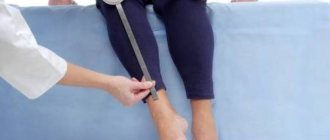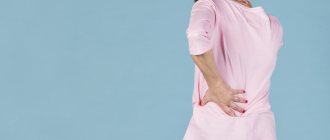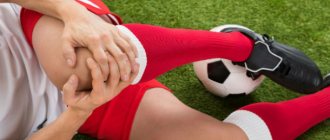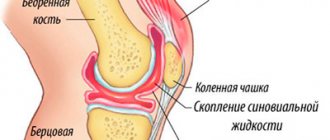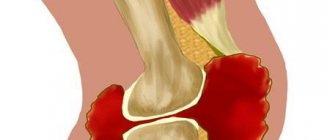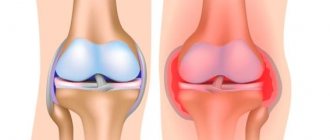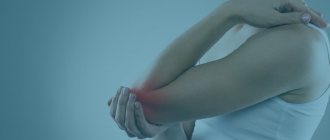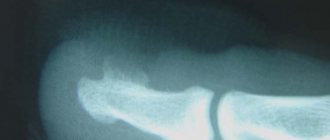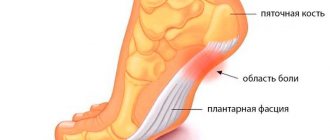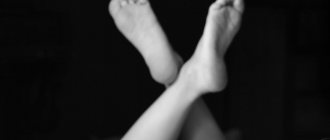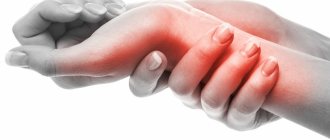Contracture (from the Latin contracture - tightening) - a temporary or permanent restriction of movement in a joint, as a result of which the limb cannot fully bend or straighten.
Contracture can be caused by diseases of the joints, nerves, blood vessels, muscles, as well as impaired elasticity of the skin and tendons.
1
Contracture. Diagnosis and treatment
2 Contracture. Diagnosis and treatment
3 Contracture. Diagnosis and treatment
The occurrence of joint contracture
According to the mechanism of occurrence, contractures are divided into 3 groups: active ( neurogenic ), passive ( structural ) and combined .
Passive contractures (or local) are distinguished by the fact that joint mobility is limited by mechanical obstacles in the joint itself or in neighboring tissues (skin, fascia, tendons, muscles).
With active contracture, there are no mechanical reasons limiting movement either in the joint itself or in the tissues surrounding it. But there is irritation from the nervous system, leading to prolonged tonic tension of certain muscle groups. An imbalance in muscle balance leads to the fact that the joints begin to “cramp”.
The initial active contracture is unstable and can be successfully corrected: the elimination of neurological disorders helps to reduce the limitation of mobility or its complete disappearance. In the absence of treatment and the progression of the disease, the contracture becomes persistent, and components of the passive form appear in it. Treatment of such contracture takes a much longer period of time.
In some cases, there are combined forms of joint stiffness, in which it is difficult to find the root cause of the disease.
If treatment for contracture is not started promptly, the disease can lead to limited mobility and disability. The severity of the condition and the disability group are determined by the degree of stiffness, the number of affected joints and the general limitation of motor activity.
Literature review
A group of Russian doctors studied the effectiveness of shockwave therapy for contractures. For the study, they selected 86 patients whose disease duration was up to 3 years. All were prescribed a course of shockwave therapy consisting of 5 sessions. During each procedure, the doctor first identified trigger points and then impacted them with impulses of varying depths. After completing the course of therapy, 80% of patients noted a significant positive effect - pain was relieved, muscle hyperspasm disappeared, trigger zones were eliminated, which collectively led to relief from contractures.
Another group of Russian scientists studied the effectiveness of shockwave therapy for myofascial syndrome. The authors included 650 patients in the study; all patients were prescribed a course of shock wave therapy. After the end of treatment, pain was relieved in 96% of the subjects and range of motion was restored.
Another group of Russian doctors conducted a study on 46 patients with post-traumatic contracture of the shoulder joint after a long period of immobilization. All patients received 5-6 sessions of shock wave therapy. After completing the course, 60% of patients noted a complete restoration of the range of motion in the joint. One patient had no effect. The rest confirmed a decrease or complete relief of pain.
Several medical groups have noted the positive effect of shockwave therapy for osteoarthritis accompanied by the formation of contractures. The inclusion of shock waves and low-frequency laser radiation in complex therapy allowed 70% of patients to achieve a pronounced therapeutic effect - pain relief and restoration of joint movements.
A study on the effectiveness of using shockwave therapy in the treatment of Dupuytren's contracture in miners was conducted by O.V. Makhotina. After a course of shock wave treatment, 57% of patients experienced a significant reduction in pain, an increase in range of motion, and a decrease in the size of pathological formations on the palmar aponeurosis.
Symptoms of contracture
The main symptom of all types of disease is difficulty in flexion and extension of the joint.
For example, with a contracture of the elbow, a person cannot move the forearm, straighten or bend the arm. With congenital joint contracture, the affected arm lags behind in development.
Knee damage is characterized by its deformation, as well as impaired support function, pain, swelling, and shortening of the leg.
1 Contracture. Diagnosis and treatment
2 Contracture. Diagnosis and treatment
3 Contracture. Diagnosis and treatment
Types of disease
In addition to the classification into active, passive and combined contractures, there are many other divisions:
- by restriction of movements - extension, flexion, rotation (limitation in turning and when making circular movements), as well as adduction and abduction;
- by the time of onset of the pathology (acquired and congenital);
- in terms of functionality - functionally disadvantageous (the performance of the limb is not preserved) and beneficial (the mobility of the joint is limited, but the performance is preserved).
Active contractures are represented by the following types:
- central neurogenic (cerebral and spinal), cerebral occur with brain damage, spinal - with damage to the spinal cord;
- peripheral neurogenic - appear when peripheral nerves are damaged, most often accompanied by pain;
- psychogenic - appear during a hysterical attack, disappear at the end of the attack.
Passive contractures consist of the following types:
- myogenic (appear as a result of muscle shortening during reflex contraction or an inflammatory process);
- arthrogenic (due to changes in the ligamentous-capsular apparatus of the joint or articular ends);
- dermatogenic (after the formation of scars on the skin as a result of burns or inflammatory diseases);
- tendogenic (due to shortening of tendons as a result of the formation of adhesions);
- immobilization (caused by prolonged restriction of movements of the arms and legs);
- ischemic (appears after fractures due to limited blood supply to the extremities);
- desmogenic (as a result of wrinkling of fascia and ligaments during deep injuries or chronic inflammatory processes. One of the most common types of desmogenic contractures is Dupuytren's contracture , which we will talk about in more detail).
Dupuytren's contracture
Dupuytren's contracture (or palmar fibromatosis) is a fibrous degeneration of the palmar aponeurosis, which, according to doctors, occurs due to a genetic predisposition. This pathology occurs 6-10 times more often in men than in women.
In most cases, the ring finger or little finger on one hand is affected; less often, the pathological process affects all fingers on both hands and feet.
A small compaction appears on the surface of the palm, similar to a nodule, which begins to gradually increase in size, cords appear, and the tendon shortens. This leads to the fact that the affected fingers become increasingly difficult to bend and straighten, and over time, immobility of the interphalangeal and metacarpophalangeal joints develops. The hand loses its functions, which causes loss of ability to work and self-care skills.
Classification of Dupuytren's contracture
1st degree of disease . The node reaches a size of about 1 cm, and some pain appears when touched. Fingers bend and straighten. Mobility in the joints is preserved.
2nd degree of the disease . The node begins to degenerate into a scar, which extends to the phalanx of the affected finger. Mobility in the affected joint is impaired. The finger with contracture is at an angle to the inner side of the palm of 30-90 degrees. The extension of the joint is impaired.
3rd degree contracture . The fibrous cord extends to the entire finger, the skin forms folds. Movement in the joints sharply worsens. Contracture appears in the metacarpophalangeal joints, which leads to complete ankylosis.
4th degree of the disease . It is possible for several fingers to fuse into a large scar. The fingers are gathered into a fist, which is completely impossible to straighten. The activity of the hand is completely impaired, which leads to disability of the patient.
1 MRI of joints
2 Treatment of contracture
3 Treatment of contracture
Treatment
Depending on the cause and severity of the disease, the doctor selects and prescribes treatment. As a rule, in the initial stages, contracture is treated with conservative methods, but it is very important to immediately begin to eliminate the cause of the pathology. An advanced case will most likely require surgical intervention, otherwise the patient will remain disabled.
Treatment in general is aimed at restoring the function of the joint and stopping its destruction; it is also very important to relieve inflammation and get rid of infection, if present. Symptomatic treatment also plays an important role if the patient is bothered by severe pain.
Conservative
Conservative treatment of contractures is a whole range of different procedures that are aimed at restoring the function of the affected part of the body. Depending on the severity of the disease, the following treatment methods are prescribed:
- Medication. For contracture, non-steroidal anti-inflammatory drugs, hormonal anti-inflammatory drugs (glucocorticosteroids), and analgesics are indicated. You may also be prescribed vitamins, chondroprotectors to restore cartilage tissue, and muscle relaxants to relax muscles.
- Visiting a chiropractor. The doctor may perform relaxation, stretching, mobilization, and compression of various parts of the body to normalize their function and relieve pain.
- Physiotherapy helps normalize blood circulation, relieve pain and inflammation. For contractures, electrophoresis, paraffin therapy, UHF, magnetic therapy, laser, etc. are prescribed.
- Therapeutic exercises and massage are carried out after pain and inflammation are relieved. These methods are aimed at restoring motor activity and strengthening muscle tissue.
- Skeletal traction is used for deformation, but now this method is rarely used; it is preferable to gradually eliminate the impairment of motor activity. Can use forced manual traction, as well as the Ilizarov apparatus, removable splints and other methods.
As a rule, all contractures that can be treated are first tried with conservative methods. If the course of therapy is not effective, the doctor will recommend treatment with surgery.
Surgical
Treatment with surgery is indicated in cases where conservative methods are not effective. For contractures, the following types of surgical intervention are used:
- Fasciotomy. In this case, the fascia is cut so that the person can flex and extend the limb.
- Scar excision, plastic surgery. This method is used in cases where contracture occurs due to a scar after injury or surgery. In this case, the scar is removed and plastic surgery is performed on the skin so that the scar no longer exists.
- Theotomy and myotomy. These methods involve cutting tendons and muscles.
- Neurotomy – dissection of the nerve trunk.
- Plastic surgery of the affected joint. This operation is performed if the contracture occurs due to destruction of the joint. Also in these cases, arthrolysis, capsulotomy, and osteotomy are performed.
Folk
For contractures, it is also possible to use folk remedies, but in complex treatment after consultation with a specialist. Traditional medicine recipes will help reduce pain, thus reducing the dosage of painkillers. If redness or a rash appears on the skin while using the product, you can no longer use it; it is better to consult a doctor immediately. The following remedies will help with contractures:
- For inflammation of muscles and joints, medicinal herbs help well, for example: string, chamomile, sage, comfrey, etc. Decoctions are made from the herb, which can be added to warm baths, compresses and ointments can be made with it.
- Paraffin compresses are also very effective, but they cannot be used in case of infection, since the sore spot may begin to fester and an abscess may form.
- A light massage with honey will help relieve inflammation and pain. To do this, you need to take a warm bath so that the sore spot is slightly steamed. Honey should be heated in a water bath until warm and rubbed with light massage movements into the sore joint for 15 minutes. This way the muscles will relax, inflammation and pain will decrease.
- Traditional healers recommend warming rubbing for contracture. It is prepared from hot chilli peppers, vegetable oil and alcohol. Mix the liquids in equal proportions and add one pod per 100 grams of product, that is, for 200 ml of liquid you will need 2 medium pods, crushed in a meat grinder or blender. The product should be infused for at least a week in a dark and cool place, then strained and rubbed on the sore joints every day, wrapping them in a downy scarf.
- Horse chestnut is also recommended for contracture. It is crushed, filled with water, closed tightly and left in a dark and cool place for 2 weeks; the vessel must be shaken periodically. After time, you need to strain the tincture and rub it into the sore joints every day until relief occurs.
Causes of contracture
Contracture most often occurs as a complication after various joint injuries: fractures, bruises, dislocations, inflammation, gunshot wounds, as well as diseases of the nervous system.
At risk are not only athletes and manual workers (loaders), who have an increased risk of damage to bones, muscles and joints, but also musicians (violinists, pianists), massage therapists, who may develop finger contracture as a result of prolonged overexertion.
Also, causes of joint stiffness can be degenerative-dystrophic and inflammatory lesions of the joints, diseases and injuries of the brain, diseases of the spinal cord, long-term placement of a limb in a cast, etc.
How to relieve muscle spasm
Muscle relaxants help relieve acute pain from muscle spasms. In mild forms of muscle contracture, you can weaken the muscles by taking a contrast shower. Due to the sharp change in temperature, blood circulation in the tissues will also improve and muscle spasms will be relieved.
Gymnastics, physical therapy, and stretching exercises will provide additional assistance in treating muscle spasms.
Physiotherapy helps eliminate the consequences of muscle spasm and the cause of its development at a deep level. Massage also does an excellent job; it will improve blood circulation, which will help relieve muscle spasms.
The latest techniques, which are based on the principle of stretching, are the first assistants for relieving muscle spasms. In any case, the treatment of muscle spasms must be approached comprehensively. This is the only way to get rid of pain and relieve muscle spasms for a long time.
Belozerova’s hardware therapy clinic is ready to provide professional assistance in the treatment of muscle spasms of various origins.
Diagnosis of contracture
The initial diagnosis is based on the patient's complaints and the appearance of the affected limb.
To determine the degree of joint stiffness, physical examinations are used to assess the range of motion during extension and flexion of the damaged part of the body.
One of the main diagnostic methods is radiography.
Depending on the nature and type of pathology, additional research methods may be used.
For neurogenic contracture, you will need to consult a neurologist; for hysterical contracture, you will need to consult a psychotherapist. For passive contracture, MRI (or CT) of the joint, as well as electroneuromyography of the joints, are prescribed.
In case of nonspecific or specific inflammation of the joints, before treating contracture, it is necessary to treat the underlying disease by a rheumatologist, phthisiatrician or venereologist.
Preventive actions
Until now, experts have not been able to find the true causes of palmar fibromatosis. As a result, until now there are no specific measures to prevent the disease.
However, in order to minimize the likelihood of pathology, for those patients who have a genetic predisposition to Dupuytren's contracture, doctors advise against abusing alcoholic beverages and tobacco products. In addition, it is recommended to practice a healthy diet and abandon a specialty associated with excessive stress on the hands.
